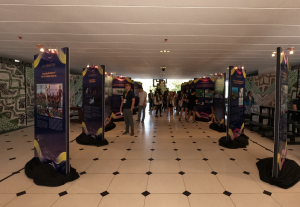 (JAN. 29)—The Office of the Vice Chancellor for Research and Development (OVCRD) opened 2020 with a conference highlighting UPD researches, creative and extension outputs.
(JAN. 29)—The Office of the Vice Chancellor for Research and Development (OVCRD) opened 2020 with a conference highlighting UPD researches, creative and extension outputs.
“Saliksikhay,” held from January 16 to 17 at the Benito Sy Pow Auditorium, College of Architecture, showcased UPD research, extension and creative activities with social impact.
Vice Chancellor for Research and Development Fidel Nemenzo underscored the kind of knowledge production outputs that UPD have across all disciplines, that is worthy and deserving of the taxpayers support.
“When you look at the program, almost all disciplines are represented, from the sciences and engineering, home economics, literature and the arts, and the social sciences as well. We also want to emphasize that ideas in UPD do not stay in the classrooms, this is why UPD in the last several years has been active in stepping up its technology transfer activities,” Nemenzo said.
Putting premium in disseminating the researches, creative and extension works, Saliksikay also showcased UPD’s effort in technology transfer.
The two-day conference featured 34 outstanding researches, creative, and extension works, divided into eight clusters, namely: education and culture, transport solutions and energy, housing and infrastructure, advance science and technology, environmental protection, food and agriculture, disaster risk reduction and resiliency, and health and wellness.
Among the projects presented were Charging in Minutes or CharM, Community-Led Integrated Non-Mercury Non-Cyanide Gold Extraction Method (CLINN-GEM), PAGLULUAL International Ceramic Art Projects, Ready-to-Drink Sweet Potato Leaf Extract (SPLE) Beverages, Honing Agents for National Disaster Awareness (HANDA) Program: Disaster Preparedness and Business Continuity Planning for MSMEs, TAKBUHAN: Design of a Resilient Evacuation Center, UPD PsyServ: Bringing GINHAWA into the UP Diliman Campus, and Sustained Support for Local Space Technology & Applications Mastery, Innovation and Advancement (STAMINA4space) Program.
CharM is a system for fast charging electric vehicles (EVs) that are using the Lithium-ion battery storage technology. CharM provides an alternative charging strategy that eliminates several hours of fully charging an EV. The conventional four to six hours slow-charging is reduced to less than an hour or even a matter of minutes for smaller vehicles.
CLINN-GEM is a technology that uses environment-friendly and non-hazardous methods of gold and/or copper extraction. The program is designed to help small-scale mining communities through introduction of technologically innovative and environment-friendly mineral processing and extractive methods. It also gives primacy in the active participation of the small-scale mining communities and partners in the whole process of the project—from planning, implementation to monitoring and evaluation.
The PAGLULUAL International Ceramic Art Projects, conducted between 2015 and 2017, were organized to ignite interest in stoneware clay, both in the production of the medium using raw materials, and in its use for ceramic art. It also aims to “initiate a cultural exchange between nations and further and further develop this art within the country.” The projects, held in the Philippines, Singapore, Thailand, Japan, United Kingdom, and the United States, featured seminars, workshops, lectures, demonstrations, kiln buildings, firing activities and exhibitions.
The Ready-to-Drink SPLE Beverages, also called KamoTea, is a healthy alternative to artificially-flavored juice drinks. It has no artificial flavors and uses natural ingredients. The main ingredient is the extract of sweet potato leaves that is known to contain vitamins, minerals, dietary fiber, antioxidants and essential fatty acids.
HANDA is a training course for micro, small and medium enterprises, cooperatives, local government units, and those interested to know more about safeguarding employees, customers, assets, and how to ensure that their organization or enterprise can prepare for natural and human-induced disruptions.
The TAKBUHAN Evacuation Center addresses the urgent need for an architectural design for a disaster-resilient structure that will solve commonly encountered problems in emergency housing. Envisioned to be the safest and most accessible place in a barangay for refugees as well as for relief providers in times of calamity, local government units, in both urban and rural locales, can utilize the design in order to ensure safety and dignity of its constituents.
The UPD PsycServ is a project developed by a team of psychologists and their associates in response to the growing need to provide mental health services for the University. The project gives importance to nurturing resilience and growth among students, faculty members and staff while also addressing their risks and vulnerabilities.
 STAMINA4Space Program is the continuation and build up of the PHL-Microsat Program—research and capacity building activities on satellite development and operation in the Philippines. The program “utilizes the gains from its predecessor towards further building and enabling environment for interdisciplinary collaboration in the country through engagements with academe, industry and other government agencies.” The program hopes to multiply the number of scientists and engineers PHL-Microsat has produced by providing scholarship programs.
STAMINA4Space Program is the continuation and build up of the PHL-Microsat Program—research and capacity building activities on satellite development and operation in the Philippines. The program “utilizes the gains from its predecessor towards further building and enabling environment for interdisciplinary collaboration in the country through engagements with academe, industry and other government agencies.” The program hopes to multiply the number of scientists and engineers PHL-Microsat has produced by providing scholarship programs.
As a parallel activity to the conference, a poster exhibit was mounted featuring of abstracts of the researches, creative works, and extension works.
The conference affirms UP’s title as the country’s national university mandated to serve as a research and public service university.
For the complete list of abstracts, please click https://saliksikhay.wordpress.com — Bino Gamba, photos by Jeff Villacruz


